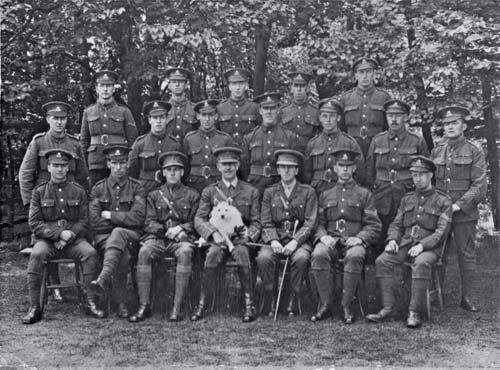
Soldier Biographies
This is the first in a series of Soldier Biographies written by Mid-Staffordshire Military Appeal Tribunals 1916-1918 volunteer Judith Gilbert, at Staffordshire Records Office, who has taken the time to research a rage of sources and write up the fascinating lives of some of Staffordshire’s First World War soldiers.
Barks; Horace (1895-1983)
From Ipstones, Horace Barks was working on the North Staffordshire railway (The Knotty) on the outbreak of war. Enlisting in the Reserve Battalion of the North Staffordshire Regiment at Butterton Hall on 8 October 1914, he answered an appeal for men to join the 5th (Territorial) Battalion as he thought it offered the prospect of going overseas sooner. Following this, the Reserve Battalion was embodied in the Territorial Army as the 2/5th North Staffordshire Regiment whilst the original 5th became the 1/5th. The Battalion formed part of the 46th (North Midland) Division, which was composed entirely of Territorials and had the distinction of being the first Territorial division to go to France as a division rather than as individual battalions.
[This information was obtained from a published interview with Horace, which took place on 31 October 1981. His autobiography was later published by the Arnold Bennett Society.]Horace had his basic training in Luton, then Saffron Walden, and then embarked for France at the end of February 1915, along with his lifelong friend, Dennis Nicklin.
While bivouacking near the village of Estaires, Horace was also accompanied by Jack Hughes, the Classics master of Hanley High School and composer of the school song, and Simmy Simms, a signalman from Leek. Horace was a stretcher bearer due to his first aid training with the railway.
In the area of Neuve Chappelle, Horace was stationed with men from the Notts and Derbys Regiment, more experienced in trench warfare. He described an informal reciprocal arrangement between the antagonists where they refrained from firing at each other or ritualised their violence so that it became predictable and, thus, harmless. This was frowned upon by General Haig, who developed a policy of sending younger, more aggressive officers to the front.
Horace was wounded three times, the first of which caused him to be invalided back to Britain and on his return to France he became a bayonet man. He was involved in the opening battle of the Somme offensive (1 July 1916) and was again wounded and invalided home after spending twelve days in a Canadian Hospital at Le Treport. After his third wound, in the shoulder, he was considered unfit for active service and transferred to a Labour Corps with the South Staffordshire Regiment.
Horace was demobbed in May 1919 when his Territorial unit was disbanded. He returned to Stoke and his job on the railway, becoming a trade union leader and then a prominent Labour councillor. He was Chairman of the Museum and Library Committee, the City Museum and the Horace Barks Reference Library are his memorials. He was Lord Mayor of the City of Stoke on Trent, and later awarded Freeman status and an OBE. As a result of his experiences in France, Horace was a passionate advocate of Esperanto and a member of an anti-war organisation during the Second World War.
[Source: Staffordshire Studies, Volume 1 1988, pp. 22-35]
